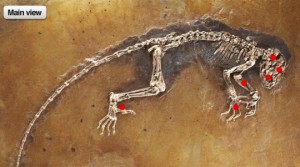Mar
21
Final(?) Word on Ida
She’s back in the news, but just barely. That 47 million-years-old skeleton of what may be the earliest-known primate, Darwinius masillae (aka “Ida”), is getting some more attention — at least, in scientific circles.
 As you may recall (go here, then come back), there was a lot of hype last year when Ida was revealed to the world with her being trumpeted as “clear proof of Darwin’s theory of evolution” and the “eighth wonder of the world”. Professor Jorn Hurum et al. were pushing the idea that Ida was not lemur-like enough to be a true strepsirrhine, so she had to be a proto-haplorhine, and therefore a distant “missing link” cousin of modern humans. But, in addition to turning up their noses at the sensationalism surrounding the find, critics said the claims being made about Ida’s place in the “family tree” (or, more accurately, “bush”) were questionable, at best, and the remains required further examination by additional experts.
As you may recall (go here, then come back), there was a lot of hype last year when Ida was revealed to the world with her being trumpeted as “clear proof of Darwin’s theory of evolution” and the “eighth wonder of the world”. Professor Jorn Hurum et al. were pushing the idea that Ida was not lemur-like enough to be a true strepsirrhine, so she had to be a proto-haplorhine, and therefore a distant “missing link” cousin of modern humans. But, in addition to turning up their noses at the sensationalism surrounding the find, critics said the claims being made about Ida’s place in the “family tree” (or, more accurately, “bush”) were questionable, at best, and the remains required further examination by additional experts.
Now, those experts have completed their study and published their own findings in the Journal of Human Evolution.
“Many lines of evidence indicate that Darwinius has nothing at all to do with human evolution,” says Chris Kirk, associate professor of anthropology at The University of Texas at Austin. “Every year, scientists describe new fossils that contribute to our understanding of primate evolution. What’s amazing about Darwinius is, despite the fact that it’s nearly complete, it tells us very little that we didn’t already know from fossils of closely related species.”
As Blythe Williams, lead researcher and anthropologist at Duke University, pointed out:
“There’s this enormous body of literature that has built up over the years. The Darwinius research completely ignored that body of literature.”
Those who determined last year that Ida was a haplorhine highlighted certain features she shared with monkeys, apes and humans — namely, a short snout and a deep jaw. But, Williams’ team points out that this is not uncommon, even among strepsirrhines (i.e., lemurs & lorises). In fact, Ida is missing most of the key anatomical features — e.g., a middle ear with two chambers and a plate of bone that shields the eyes from the chewing muscles — that would place her firmly in the haplorhini Suborder. Thus, says Kirk. “[Y]ou can forget about Darwinius being a close relative of humans or other anthropoids.”
I knew it all along….















